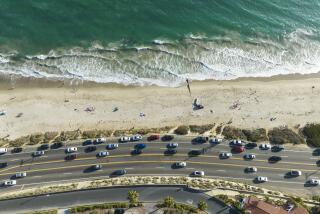Future of O.C. Beaches Is Murkier After Spill
- Share via
Up to 5,000 gallons of raw sewage oozed out of an aging pipeline into already troubled waters off Huntington Beach and Newport Beach on Tuesday, the 23rd spill to close county beaches this year--one more than all of 1999.
Nearly two miles of prime beach is now closed or posted with warnings not to enter the water because of the spill, combined with soaring bacteria levels. Another dye study that starts today will try to find the source of the pollution.
Officials throughout California and the nation are watching Orange County beaches closely. With the cause of last summer’s devastating shoreline closures still a mystery, and bacteria levels rising along Huntington Beach since late March, there are heightened fears of a second straight summer of closed beaches that could hurt more than just the Surf City image.
“Everyone is terrified,” said Susan Jordan, board member of the League for Coastal Protection. “You have a $12-billion coastal industry here in California . . . and it cannot function with closed beaches.”
Wayne Baglin, chairman of the California Regional Water Quality Control Board in San Diego, said he has spoken with water officials and environmentalists nationwide.
“The entire state is looking at Huntington Beach, not only because we’re all fearful it will happen in our areas,” Baglin said. “We’re all so hopeful they are going to come up with a solution to the problem, because they’ll probably end up being the solution to many of our problems.”
Local, county and California officials have poured millions of dollars into studies to find the source of last summer’s pollution. Officials say the long-term picture won’t improve until there is increased investment in infrastructure, like the aging pipe that burst Tuesday; penalties for polluters; and mandated spill-prevention plans and backup systems. Activists say the long-term solution is a fundamental change in behavior by developers, other businesses and ordinary residents, inland as well as along the coast.
The latest woes include:
* The shoreline will be off-limits until at least Friday from Orange Avenue in Newport Beach to Talbert Channel in Huntington State Beach. An Orange County Sanitation District pipeline broke at 5 a.m. Tuesday near College and Gisler avenues in Costa Mesa. It flowed from the 1970s-era pipeline into a storm drain that emptied into the Greensville Banning Channel and then flowed into the Santa Ana River, which dumped it into the ocean off Huntington Beach.
Had the spill occurred just a few hours later, though, it probably would have released tens of thousands of gallons more.
“Unfortunately pipes do break,” said Michelle Tuchman, spokeswoman for the Orange County Sanitation District. “This one broke . . . when the flow was low. Certainly if it was during a high-flow period there would have been more sewage.”
* Bacteria levels from an unknown source also caused county health officials to urge swimmers to avoid the water from Magnolia Street to Talbert Channel at Huntington State Beach.
* State officials closed Huntington State Beach from Newland Street to the Santa Ana River. The beach is expected to reopen Thursday. USC researchers will conduct a second magenta dye study to try to pinpoint the mysterious source of bacteria. Preliminary results from a similar study of the 9,000-foot stretch last week supported suspicions that runoff flowing from Talbert Marsh through the channel into the ocean is a contributor.
Urban runoff is the brew of chemicals, metals and bacteria that washes off lawns and streets into storm drains, which flow into area waterways that lead to the ocean.
Talbert Marsh, on the inland side of Pacific Coast Highway at Brookhurst Street, is a 25-acre wetland that attracts thousands of migratory birds and other wildlife. Twelve square miles of Huntington Beach and Fountain Valley drain through it into the Pacific Ocean.
The city will also stop eight pump stations today that bring urban runoff to the ocean so researchers can test water quality in several more areas during the next week.
“We’re trying to be comprehensive,” said Rich Barnard, a Huntington Beach spokesman. “Once we get the results of these studies, we’ll be in a position to aggressively address them.”
Activists say the solution is clear--a dramatic shift in individual and societal behavior.
Christopher J. Evans, executive director of the Surfrider Foundation in San Clemente, said, “The beach starts at our doorstep. Everything we put in our toilets and gutters eventually goes into the ocean. We have to take better care of our Mother Ocean.”
(BEGIN TEXT OF INFOBOX / INFOGRAPHIC)
Triple Whammy
County officials warn swimmers to avoid two miles of coast today because of a sewage spill, high bacterial counts and a dye test.
Source: Orange County Sanitation District
* CREEK CLEANUP
O.C. supervisors approve a state study of the polluted San Juan Creek watershed. B1
More to Read
Sign up for Essential California
The most important California stories and recommendations in your inbox every morning.
You may occasionally receive promotional content from the Los Angeles Times.














